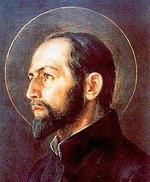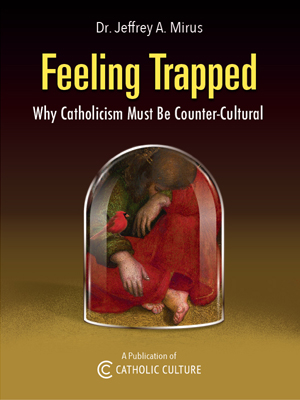Congregation Publishes New Rite of Exorcism
by Cardinal Jorge Arturo Medina Estevez
On Tuesday, 26 January, Cardinal Jorge Arturo Medina Estevez, Prefect of the Congregation for Divine Worship and the Discipline of the Sacraments, held a press conference to present the new rite of exorcism in the Roman Ritual. Here are excerpts of Cardinal Medina's presentation, which was given in Italian.
In order to understand what exorcism is we must start with Jesus Christ and what he did.
Jesus Christ came to announce and inaugurate God's reign over the world and human beings. Men and women are capable of welcoming God into their hearts. However, this ability to accept God becomes obscured by sin, and sometimes evil occupies the place where God wishes to dwelt. This is why Jesus Christ came to set man free from the domination of evil and sin, and thus from all other forms of domination by the Evil One. Christ cast out devils and delivered people from possession by evil spirits, so that man could freely respond to God, who wants to give him his Holy Spirit and to direct his steps towards peace and salvation.
The Church is called to follow Jesus Christ and has received from him the power to continue his mission. Therefore Christ's action of freeing man from evil is exercised through the Church and her ordained ministers, appointed by the Bishop to carry out the sacred rites intended to deliver men and women from possession by the devil. Exorcism is thus an ancient form of prayer which the Church uses against the power of the devil. The Catechism of the Catholic Church explains:
"When the Church asks publicly and authoritatively in the name of Jesus Christ that a person or object be protected against the power of the Evil One and withdrawn from his dominion, it is called exorcism. Jesus performed exorcisms (Mk 1:25f.) and from him the Church has received the power and office of exorcising (Mk 3:15; 6:7, 13; 16: 17). In a simple form, exorcism is performed at the celebration of Baptism. The solemn exorcism, called 'a major exorcism', can be performed only by a priest and with the permission of the Bishop. The priest must proceed with prudence, strictly observing the rules established by the Church. Exorcism is directed at the expulsion of demons or to the liberation from demonic possession through the spiritual authority which Jesus entrusted to his Church. Illness, especially psychological illness, is a very different matter; treating this is the concern of medical science. Therefore, before an exorcism is performed, it is important to ascertain that one is dealing with the presence of the Evil One, and not an illness (cf. Code of Canon Law, can. 1172)" (n. 1673).
Sacred Scripture teaches us that evil spirits operate in different ways; a particular form is diabolical "obsession", also called diabolical "possession". But diabolical obsession is not the most frequent way the spirit of darkness exerts his influence. Obsession has sensational features, in which the devil in a certain way takes over the physical powers of the possessed person. However, the devil cannot control the subject's free will and thus cannot cause him to sin. Nevertheless, the physical violence that the devil exerts over the obsessed person is an inducement to sin and this is what he seeks. The ritual of exorcism indicates various criteria and signs which allow us to reach the prudent conviction that we are dealing with diabolical possession. It is then that the authorized exorcist can perform the solemn rite of exorcism. These criteria include: speaking many words in unknown languages or understanding them; revealing distant or hidden things; displaying strength beyond one's condition, together with a vehement aversion to God, Our Lady, the saints, the cross and sacred images.
We should stress that the diocesan Bishop's authorization is required to perform an exorcism; this authorization can be granted for a specific case or in a general, permanent way to the priest who exercises the ministry of exorcist in the Diocese. The Roman Ritual contained the instructions and liturgical text for exorcisms in a special chapter. This was the last chapter and had not been revised after the Second Vatican Council. The revision has taken 10 years, resulting in the current text approved by the Supreme Pontiff, which is made public today and is available to the Pastors and faithful of the Church. One more task still remains within the competence of the respective Bishops' Conferences: the translation of this Ritual into the languages spoken in the various regions; these translations must be precise and faithful to the Latin original, and must be submitted, in accordance with canon law, for the recognitio of the Congregation for Divine Worship.
The Ritual we are presenting today contains, first of all, the rite of exorcism properly so-called, to be performed on a possessed person. This is followed by the prayers to be publicly recited by a priest, with the Bishop's permission, when it has been carefully determined that there is a satanic influence over places, objects or persons, but which has not reached the point of a true and proper possession. Also, there is a collection of prayers to be recited privately by the faithful whenever they have reason to suspect they are undergoing diabolical influence.
Exorcism is based on the faith of the Church, which holds that Satan and the other evil spirits exist and that their activity consists in diverting human beings from the way of salvation. Catholic doctrine teaches us that the demons are angels who have fallen because of sin, that they are spiritual beings of great intelligence and power, but I would like to stress that the evil influence of the devil and his followers is usually exercised through deceit and confusion. Just as Jesus is the Truth (cf. Jn 8:44), so the devil is the liar par excellence. He deceives human beings by making them believe that happiness is found in money, power or carnal desire. He deceives them into thinking that they do not need God, that grace and salvation are unnecessary. He even deceives them by diminishing the sense of sin or even suppressing it altogether, replacing God's law as the criterion of morality with the habits or conventions of the majority.
The Church is certain of Christ's final victory and does not let herself be swayed by fear or pessimism, but she is aware of the action of the Evil One, who seeks to discourage us and to sow confusion. "Be of good cheer", the Lord says, I have overcome the world" (Jn 16:33). Exorcism, an important but not the only expression of the struggle against the devil, should be seen in this context.
© L'Osservatore Romano, Editorial and Management Offices, Via del Pellegrino, 00120, Vatican City, Europe, Telephone 39/6/698.99.390.
This item 851 digitally provided courtesy of CatholicCulture.org






